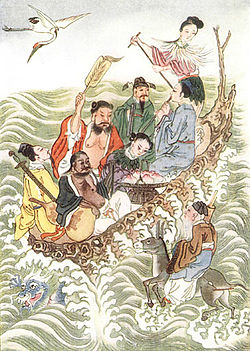The eight immortals

The Eight Immortals (Chinese, 八仙; pinyin, Bāxiān; Wade-Giles, Pa Hsien) are a group of deities from Chinese mythology, according to which they existed on earth and were born during the Tang or Song dynasties, practicing alchemy techniques and oriental immortality methods. (understood as obtaining an extremely long life) until reaching true final immortality through the Tao.
They were first described during the Yuan Dynasty and in Western literature prior to the 1970s they were sometimes referred to as 'The Eight Geniuses'. They are worshiped within Taoism, but also in popular Chinese culture.
Members of the party rarely appear separately, and the powers of each of them can be transferred to utensils that can give life or destroy evil and are known as An Baxian (暗八仙, Àn Bāxiān, "The Eight Hidden Immortals"). In Chinese they give their name to the hydrangea (八仙花,Bāxiān huā, "Flower of the Eight Immortals").
The Eight Immortals
The Eight Immortals are:
- Lü Dongbin
- Lan Caihe
- Zhang Guo Lao
- He Xiangu
- Li Tieguai
- Han Xiangzi
- Zhongli Quan
- Cao Guojiu
Literature
The Eight Immortals have served as the basis for many works of art, both in the field of sculpture, painting and literature. Within the latter, The Journey to the East of the Eight Immortals (八仙出处东游记, 八仙出處東游記, Bāxiān chū chù dōng yóu jì) from the Ming dynasty stands out.
Also at this time, an anonymous author wrote The Eight Immortals Cross the Sea (八仙过海, 八仙過海, Bāxiān guò hǎi), which narrates their journey to attend the anniversary party of the goddess Xi Wangmu, called Meeting of the Peach Tree of Immortality (蟠桃会, 蟠桃會, pán táo huì). Upon reaching the sea, instead of using their clouds to cross, Lü Dongbin suggests that they unite their powers to cross the waters. This is where the Chinese proverb "the Eight Immortals cross the sea, each revealing his divine power" (八仙過海 各顯神通, 八仙过海 各显神通, Bāxiān guò hǎi gè xiǎn shén tōng), used in situations where everyone offers their abilities to achieve a common goal.
Each of the immortals represents a facet of Chinese society and therefore the story of "the eight immortals cross the sea" It represents the tasks that the nation can fulfill when there is harmony between each of its parts. The groups they represent are clearly seen in the biography of each one. Zhongli Quan represents the military; Lü Dongbin to the bureaucrats; Li Tieguai to the sick and injured; Han Xiangzi to the sages; Cao Guojiu represents the nobility; Zhang Guo Lao to the elders; Lan Caihe to the poor and He Xiangu to the maidens.
Cult of the Eight Immortals
In Xi'an there is a Song dynasty temple called the Palace of the Eight Immortals (八仙宫, 八仙宮, bāxiān gōng), formerly called the Temple of the Eight Immortals (八仙庵, Bāxiān ān), where you can see their statues in the Hall of the Eight Immortals (八仙殿, Bāxiān diàn). In Muzha (木栅, 木柵, Mùzhà), in Taipei (Taiwan) is the South Palace (南宫, 南宮, Nángōng), known as the Temple of the Eight Immortals (八仙廟, Bāxiān miào).
Other groups of Eight Immortals
In Chinese mythology and history there have been other groups of eight people called immortals, such as:
- The Eight Immortals of Wine
- The Eight Immortals of Huainan
- The Eight Immortals of Sichuan
- The Eight Immortals of the Chinese Communist Party
Contenido relacionado
Religion in Guatemala
Hollywood
The Ten Commandments (1956 film)